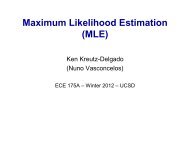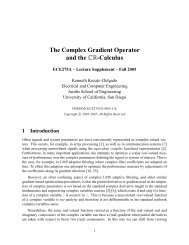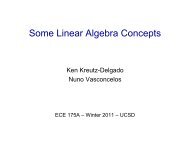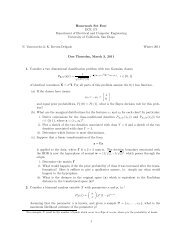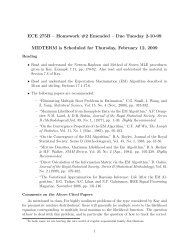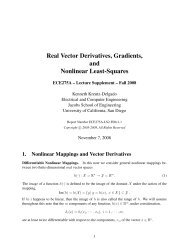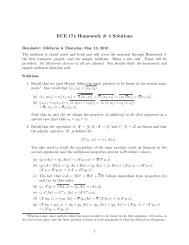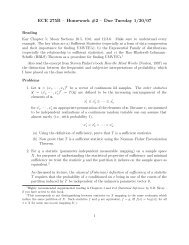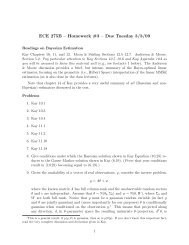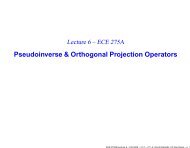ECE 174 Homework # 4 Solutions - UCSD DSP Lab
ECE 174 Homework # 4 Solutions - UCSD DSP Lab
ECE 174 Homework # 4 Solutions - UCSD DSP Lab
You also want an ePaper? Increase the reach of your titles
YUMPU automatically turns print PDFs into web optimized ePapers that Google loves.
<strong>ECE</strong> <strong>174</strong> <strong>Homework</strong> # 4 <strong>Solutions</strong><br />
Reminder: Midterm is Tuesday, May 19, 2009<br />
The midterm is closed notes and book. Bring paper and pen only. No Electronic devices at<br />
all are allowed. You are encouraged to study the homework and sample midterm solutions<br />
well.<br />
<strong>Solutions</strong><br />
1. Recall that we (and Meyer) define the inner product to be linear in the second argument.<br />
1 Also recall that 〈x1, x2〉 = 〈x2, x2〉.<br />
(a) 〈x1, αx2〉 = α 〈x1, x2〉 = α 〈x1, x2〉 = α 〈x2, x1〉 = 〈x2, αx1〉 = 〈αx1, x2〉.<br />
(b) 〈α1x1 + α2x2, x〉 = 〈x, α1x1 + α2x2〉 = α1 〈x, x1〉 + α2 〈x, x2〉<br />
= α1 〈x1, x〉 + α2 〈x2, x〉<br />
Note that in part (b) we obtain the property of additivity in the first argument as a<br />
special case (just take α1 = α2 = 1).<br />
2. Recall that the operators A : X → Y, B : X → Y, and C : Y → Z are linear and that<br />
the adjoint operator, A ∗ , is defined by<br />
〈A ∗ x1, x2〉 = 〈x1, Ax2〉 .<br />
You also need to recall the properties of the inner product (such as linearity in the<br />
second argument) and the additional properties proved in Problem 1 above.<br />
(a) 〈y, αAx〉 = 〈y, Aαx〉 = 〈A ∗ y, αx〉 = 〈αA ∗ y, x〉.<br />
(b) 〈y, (A + B)x〉 = 〈y, Ax + Bx〉 = 〈y, Ax〉 + 〈x, Bx〉 = 〈A ∗ y, x〉 + 〈B ∗ y, x〉<br />
〈A ∗ y + B ∗ y, x〉 = 〈(A ∗ + B ∗ )y, x〉.<br />
(c) The fact that (αA + βB) ∗ = αA ∗ + βB ∗ follows immediate from properties (b)<br />
and (a), in that order.<br />
(d) 〈x, A ∗ y〉 = 〈A ∗ y, x〉 = 〈y, Ax〉 = 〈Ax, y〉.<br />
(e) 〈z, CAx〉 = 〈C ∗ z, Ax〉 = 〈A ∗ C ∗ z, a〉.<br />
(f) 〈A ∗ αy, x〉 = 〈αy, Ax〉 = α 〈y, Ax〉 = α 〈A ∗ y, x〉 = 〈αA ∗ y, x〉.<br />
(g) 〈A ∗ (y1 + y2), x〉 = 〈y1 + y2, Ax〉 = 〈y1, Ax〉 + 〈y2, Ax〉 = 〈A ∗ y1, x〉 + 〈A ∗ y2, x〉<br />
= 〈A ∗ y1 + A ∗ y2, x〉.<br />
(h) Linearity of A ∗ follows from properties (g) and (f), in that order.<br />
1 Whereas many other authors define the inner product to be linear in the first argument. Of course, in<br />
the real vector space case the inner product is linear in both arguments so that the distinction disappears.<br />
1
3. Recall that the inner–products are defined as,<br />
〈x1, x2〉 = x H 1 Ωx2 and 〈y1, y2〉 = y H 1 W y2 ,<br />
where Ω and W are hermitian (i.e., Ω H = Ω and W H = W ) and positive–definite (and<br />
hence both are invertible). Note that in this case their inverses are also hermitian,<br />
positive–definite.<br />
(a) 〈y, Ax〉 = y H W Ax = y H W AΩ −1 Ωx = (Ω −1 A H W )y H Ωx = (Ω −1 A H W )y, x .<br />
(b) For r(A) = n, A has full column rank and it must be the case that m ≥ n. Since<br />
A is possibly over–determined, we solve the least squares problem by enforcing<br />
the geometric condition that y − Ax ∈ R(A) ⊥ = N (A ∗ ). This yields the normal<br />
equations,<br />
A ∗ Ax = A ∗ y .<br />
Because r(A) = n, the n×n matrix A ∗ A also has rank n and is therefore invertible.<br />
(This fact is consistent with the nullspace of A being trivial, so that the least–<br />
squares problem must have a unique solution.) Thus, we have that<br />
r(A) = n ⇒ x = (A ∗ A) −1 A ∗ y ,<br />
for any value of y. It must therefore be the case that<br />
r(A) = n ⇒ A + = (A ∗ A) −1 A ∗ ,<br />
where A ∗ = Ω −1 A H W as determined in Part (a). With W a full rank hermitian<br />
matrix and r(A) = n, it is the case that A H W A is invertible and as a consequence<br />
the pseudoinverse, A ∗ , is independent of the weighting matrix Ω,<br />
r(A) = n ⇒ A + = (A H W A) −1 A H W .<br />
(c) For r(A) = m, A has full row–rank and therefore it must be the case that n ≥ m.<br />
Note that A is onto, and therefore y = Ax is solvable for all y. However, the system<br />
is possibly underdetermined, so we want to look for a minimum norm solution.<br />
This requires that we enforce the constraint that any solution to y = Ax must<br />
also satisfy the geometric condition that x ∈ N (A) ⊥ = R(A ∗ ). This condition is<br />
equivalent to,<br />
x = A ∗ λ ,<br />
for some vector λ.<br />
This condition, together with the requirement that x be a solution to y = Ax, yields,<br />
AA ∗ λ = y .<br />
2
Because r(A) = m, the m × m matrix AA ∗ also has rank n and is invertible. Thus,<br />
which yields the result that<br />
for all y. Thus,<br />
λ = (AA ∗ ) −1 y<br />
r(A) = m ⇒ x = A ∗ (AA ∗ ) −1 y ,<br />
r(A) = m ⇒ A + = A ∗ (AA ∗ ) −1 .<br />
With r(A) = m and Ω −1 a hermitian full–rank matrix, it is the case that the m × m<br />
matrix AΩ −1 A H is invertible. With the fact that A ∗ = Ω −1 A H W , this yields the fact<br />
that for r(A) = m, the pseudoinverse is independent of the weighting matrix W ,<br />
r(A) = m ⇒ A + = Ω −1 A H (AΩ −1 A H ) −1 .<br />
4. The minimum power–dissipation problem. We will solve part (b) first, then part (a).<br />
(b) x = (I1, I2, I3) T , A = (1, 1, 1), and y = I. Note that the rank of A is m = 1, so<br />
that A is onto (has full row rank) and therefore A + = A ∗ (AA ∗ ) −1 . The inner product<br />
on the domain (“input space”) has weighting matrix Ω = diag(R1, R2, R3).<br />
With this setup we have that the total power dissipated in the resistors is P =<br />
x 2 . The inner product on the codomain (“output space”) can be taken to have<br />
a weighting “matrix” W = 1. The adjoint operator is<br />
Also,<br />
This yields,<br />
A ∗ = Ω −1 A T W = Ω −1 A T =<br />
(AA ∗ ) −1 = (AΩ −1 A T ) −1 =<br />
1<br />
R1<br />
1<br />
+ 1<br />
R2<br />
A + = A ∗ (AA ∗ ) −1 = Ω −1 A T (AΩ −1 A T ) −1 =<br />
<br />
1<br />
,<br />
R1<br />
1<br />
,<br />
R2<br />
1<br />
R3<br />
+ 1<br />
R3<br />
Thus the optimum currents through the resistors are<br />
⎛ ⎞<br />
I1<br />
⎝ ⎠ = x = A + I<br />
y =<br />
I2<br />
I3<br />
=<br />
R2R3 + R1R3 + R1R2<br />
3<br />
T<br />
.<br />
R1R2R3<br />
R2R3 + R1R3 + R1R2<br />
1<br />
R2R3 + R1R3 + R1R2<br />
⎛<br />
⎝<br />
R2R3<br />
R1R3<br />
R1R2<br />
⎞<br />
⎠ .<br />
⎛<br />
⎝<br />
.<br />
R2R3<br />
R1R3<br />
R1R2<br />
⎞<br />
⎠ .
Note that I1 + I2 + I3 = I as required. The vector of optimal voltages is given by<br />
the vector Ωx and yields the answer,<br />
V1 = V2 = V3 =<br />
R1R2R3<br />
R2R3 + R1R3 + R1R2<br />
The optimum (minimum) solution power dissipation is computed as,<br />
Note that<br />
P opt = x 2 = x T Ωx = (A + y) T ΩA + y = y T A +T ΩA + y .<br />
A +T ΩA + = (AΩ −1 A T ) −1 AΩ −1 A T (AΩ −1 A T ) −1 = (AΩ −1 A T ) −1 ,<br />
which was computed above. Therefore,<br />
P opt = I 2<br />
which is dimensionally correct (“P = I 2 R”).<br />
(a) x = (V1, V2, V3) T ,<br />
R1R2R3<br />
R2R3 + R1R3 + R1R2<br />
<br />
1<br />
A = ,<br />
R1<br />
1<br />
,<br />
R2<br />
1<br />
<br />
,<br />
R3<br />
and y = I. The rank of A is m = 1, so that A is onto (has full row rank) and<br />
therefore A + = A ∗ (AA ∗ ) −1 . The inner product on the domain (“input space”)<br />
has weighting matrix,<br />
<br />
1<br />
Ω = diag ,<br />
R1<br />
1<br />
,<br />
R2<br />
1<br />
<br />
.<br />
R3<br />
With this setup we again have that the total power dissipated in the resistors is<br />
P = x 2 . And again the inner product on the codomain (“output space”) can<br />
be taken to have a weighting “matrix” W = 1. The adjoint operator is<br />
Also,<br />
This yields,<br />
(AA ∗ ) −1 = (AΩ −1 A T ) −1 =<br />
A ∗ = Ω −1 A T W = Ω −1 A T = (1, 1, 1) T .<br />
1<br />
R1<br />
1<br />
+ 1<br />
R2<br />
+ 1<br />
R3<br />
A + = A ∗ (AA ∗ ) −1 = Ω −1 A T (AΩ −1 A T ) −1 =<br />
4<br />
=<br />
,<br />
I .<br />
R1R2R3<br />
R2R3 + R1R3 + R1R2<br />
R1R2R3<br />
R2R3 + R1R3 + R1R2<br />
.<br />
⎛ ⎞<br />
1<br />
⎝1⎠<br />
.<br />
1
With the optimal solution given by x = A + y this yields optimum voltages of<br />
V1 = V2 = V3 =<br />
R1R2R3<br />
R2R3 + R1R3 + R1R2<br />
exactly as before. The optimum (minimum) solution power dissipation is again<br />
computed as,<br />
where<br />
P opt = x 2 = x T Ωx = (A + y) T ΩA + y = y T A +T ΩA + y ,<br />
A +T ΩA + = (AΩ −1 A T ) −1 AΩ −1 A T (AΩ −1 A T ) −1 = (AΩ −1 A T ) −1 ,<br />
which was computed above. Therefore,<br />
exactly as before.<br />
P opt = I 2<br />
R1R2R3<br />
R2R3 + R1R3 + R1R2<br />
5. The two situations correspond to the mutually exclusive cases of a) b is in the range<br />
of A, and b) nonzero b is not in the range of A.<br />
6. Meyer Problem 4.6.7. Let the data pairs be given by (xk, yk), k = 1, · · · , m = 11.<br />
(E.g., (x1, y1) = (−5, 2), etc.). For both the line fit and the quadratic fit, we want to<br />
place the problem in the vector–matrix form,<br />
y = Aα<br />
for A m × n, where n is the dimension of the unknown parameter vector α, and solve<br />
for α in the least-squares sense. For the linear fit we have,<br />
⎛ ⎞<br />
y1<br />
⎜ y2<br />
⎟<br />
y = ⎜ ⎟<br />
⎝ . ⎠<br />
ym<br />
=<br />
⎛<br />
1<br />
⎜<br />
⎜1<br />
⎜<br />
⎝.<br />
⎞<br />
x1<br />
x2<br />
⎟ <br />
⎟ α0<br />
⎟ = Aα ,<br />
. ⎠ α1<br />
1 xm<br />
with n = 2. While for the quadratic fit we have,<br />
⎛ ⎞<br />
y1<br />
⎜ y2<br />
⎟<br />
y = ⎜ ⎟<br />
⎝ . ⎠<br />
ym<br />
=<br />
⎛<br />
1<br />
⎜<br />
⎝<br />
x1 x2 1 x2<br />
1<br />
x2 . .<br />
2<br />
.<br />
1 xm x2 ⎞<br />
⎛<br />
⎟ ⎝<br />
⎠<br />
m<br />
α0<br />
α1<br />
α2<br />
⎞<br />
,<br />
⎠ = Aα ,<br />
with n = 3. Note that in both cases we have the data to fill in numerical values of y<br />
and A. In both cases we have that the matrix A is full rank (you can check in matlab,<br />
5<br />
I ,
ut it will usually be true for this type of problem). Thus the least squares solution<br />
can be determined as,<br />
α = (A T A) −1 A T y .<br />
The optimal least–squares error has magnitude,<br />
e 2 = y − Aα 2 = (y − Aα) T (y − Aα) ,<br />
which can be computed for both the quadratic and linear fits. In this case you will<br />
find that the quadratic fit provides a much tighter fit to the data. Once you have the<br />
parameters at hand, you can perform the prediction by plugging in the new value for<br />
xk.<br />
Question:<br />
Given measured data (xk, yk), k = 1, · · · , m can you fit the model,<br />
Or the model,<br />
y ≈ α0 + α3x 3 + α9x 9 ?<br />
y ≈ αx + βe x + γ cos(12x 3 ) ?<br />
6



